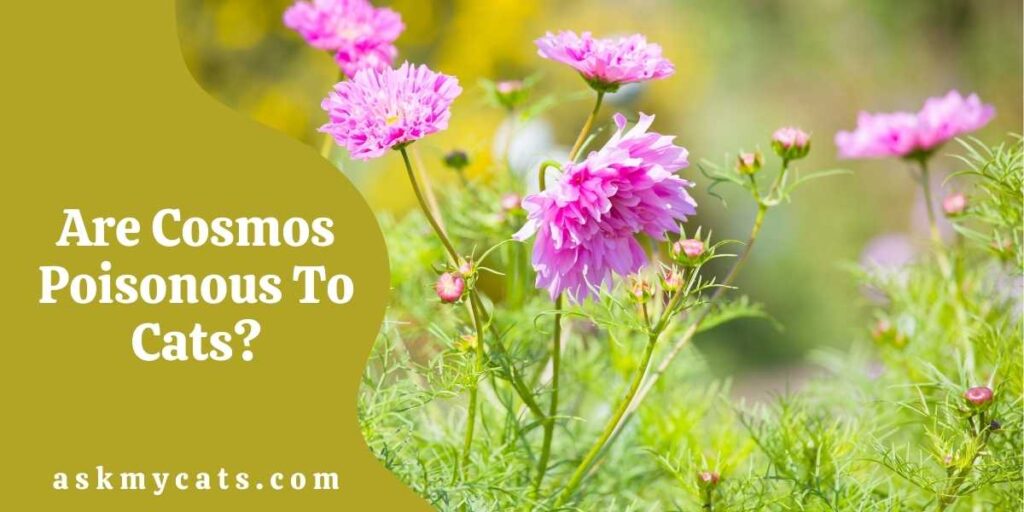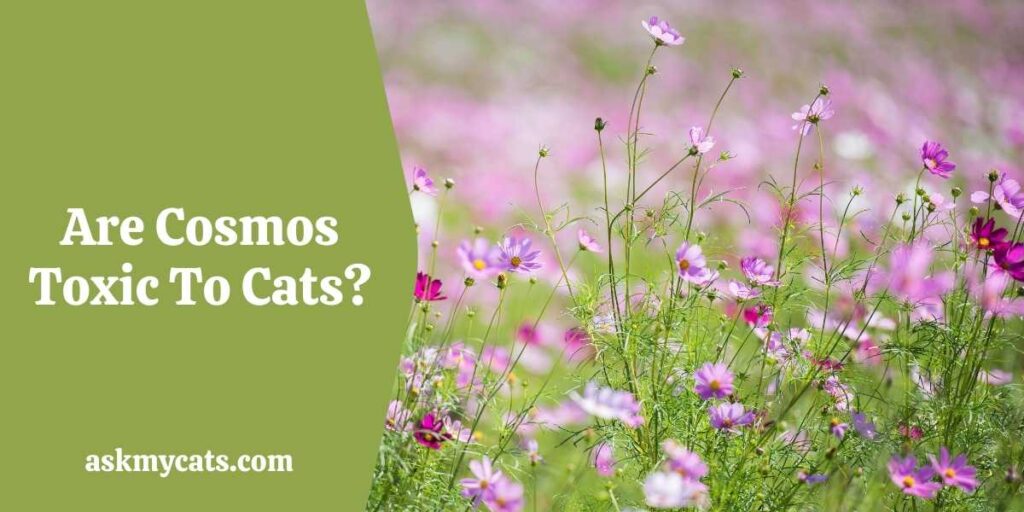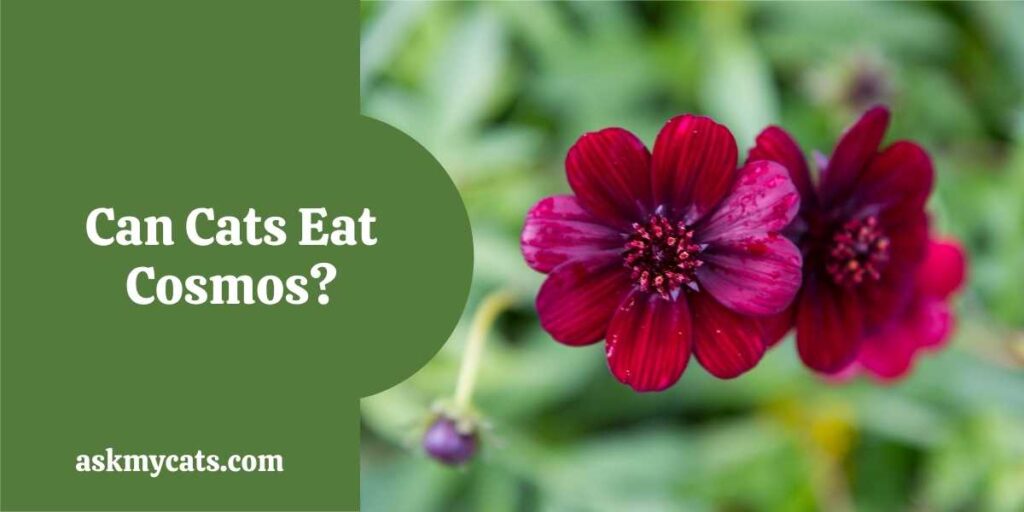Gardeners that are passionate about flowers of all types, shapes, and sizes love to fill their beautiful gardens and homes with flowers of all sorts, shapes, and sizes.
Plants have been found to be wonderful stress relievers in addition to adding a splash of colour and personality to your room.
Regrettably, not all plants are suitable for our pets. No matter how much you adore your flowers, the cat is unquestionably your favourite.
So, are cosmos poisonous to cats?
No, cosmos are not poisonous to cats. There are no harmful ingredients in the plant’s blooms, leaves, or stems, so there’s no need to be concerned.
Keep reading this article to get an insight into the relationship between cats and the cosmos.


Give Your Cat the Perfect Day
Get the Free Ebook!
What Are Cosmos?
Cosmos is a genus, with the same common name of cosmos, consisting of flowering plants in the sunflower family.
Cosmos are herbaceous perennial or annual plants that grow to a height of 0.3–2 metres (1 ft 0 in–6 ft 7 in).
Simple, pinnate, or bipinnate leaves are arranged in opposite pairs. Flowers are produced in a capitulum with a ring of wide ray florets and a disc floret centre; bloom colour varies greatly between species.
Several attractive plants common in gardens belong to this genus. A large number of hybrids and cultivars have been chosen and given names.
The majority of Cosmos species are found in scrub and meadowland habitats in Mexico. Some variants can be found as far north as Washington’s Olympic Peninsula, but the range also extends through Central America and into South America as far south as Paraguay[citation needed.
C. bipinnatus, for example, has been naturalised throughout much of the eastern United States and eastern Canada.
It’s also common in South Africa’s high eastern plains, where it was spread by tainted horse feed during the Anglo-Boer War.
Cosmos are easy to cultivate in gardens and make excellent cut flowers. Plants that have been established can withstand drought, poor soil conditions, and general neglect. They even have the ability to self-sow. This plant is extremely low-maintenance.
While some pests adore cosmos, such as aphids, flea beetles, and thrips, they’re easy to eliminate with a powerful spray of water or insecticidal soap.
Cosmos are susceptible to aster yellows, bacterial wilt, and powdery mildew. Plants should be spaced appropriately to enable adequate ventilation and minimise illness.
Are Cosmos Toxic To Cats?
No, cosmos are not toxic to cats.

Cosmos blooms grow on long, slender stems and produce vibrant hues that draw attention throughout the summer.
Butterflies, bees, and birds will visit your garden as well.
There are several types that look fantastic in a garden setting. Taller types work well in the back border or in the middle of the garden, while shorter varieties work well as edging plants.
Cosmos are popular among flower lovers for two reasons. For starters, they are quite simple to grow.
All you have to do now is scatter the seeds across your garden. They will have attained maturity in two months.
They will sprout in no time if they have access to sunlight, relatively fertile soil, and water. Furthermore, they perform admirably in a container. The more you pick the flower, the more it will bloom.
The fact that they are not poisonous to cats is the second reason for their popularity. There are no harmful components in the plant that would harm a cat’s system.
The stem, blooms, and leaves are all completely safe for your cat and pet. As a result, you can grow the flower as a houseplant without fear of your cat developing an allergy or stomach problem.
The flower is not only harmless for cats, but also for dogs and children. This is why this species of flower is commonly found in gardens.
Of course, if your cat consumes a large amount of Cosmos, it may become ill. A stomach upset is unavoidable if you consume too much of the herb.
Your cat may subsequently experience stomach pains, vomit, or have watery stools. If this occurs, take the cat to the veterinarian for a check-up to avoid future complications.
Can Cats Eat Cosmos?
Yes, cats can eat cosmos, but only in moderation.

No cat species is poisoned by Cosmos.
Cats, on the other hand, are rash when it comes to tree climbing.
It’s possible the thrones and foliage will also be shredded.
Cosmos don’t produce any potentially dangerous compounds, thus cats are safe in this situation.
Ingesting the leaves, on the other hand, could be harmful to one’s health. Cosmos is non-toxic and has no effect on cats when consumed in moderation.
Cosmos is a plant species that has been shown to be safe for both cats and humans.
You can keep them at home to add to the aesthetic appeal of the space. At the same time, you can incorporate it into your family’s garden.
Cosmos isn’t poisonous to cats. Cats, on the other hand, may have harmed your cosmos. Unlike aloe vera, Cosmos does not contain any potentially harmful chemicals.
Your cat will have no trouble nibbling on the leaves of the cosmos plant. Your cat could also tear the leaves off, destroying them.
Cats, on the other hand, are carnivores with digestive systems that aren’t designed to deal with large amounts of plant matter.
As a result, your cat might have a few minor symptoms that could be mistaken for poisoning.
Cosmos, is a flowering plant that is not toxic to cats and does not affect them in any way.
Cats, on the other hand, should not be allowed to eat these plants since they might cause vomiting or diarrhoea if taken in significant amounts.
Although the plant’s effects on cats are less severe than on humans, this does not mean you should feed the plant leaves to your cats.
When your cat consumes a big amount of cosmos, his stomach will become disturbed, resulting in vomiting or diarrhoea.
The plant’s effects on cats are mild and only become apparent if large amounts of the leaves are taken.
Only if consuming a plant causes death or some other major condition can it be considered poisonous.
Fortunately, the Cosmos plant is harmless for cats and does not cause poisoning.
There are only a few plants that are safe for all cats. The cosmos plant, on the other hand, has established a reputation as a pet-friendly plant because it is not toxic to most animals. Because there are no poisons in any part of the plant, it is perfectly safe to eat for cats.
As a result, the plant has gained a reputation for being pet-friendly. Plants have been found to be animal-friendly on numerous occasions.
Most indoor plants, on the other hand, can be toxic to cats. The blossoms of cosmos, on the other hand, do not fall into this category. These plants are safe for cats and are non-toxic.
Symptoms Of Cosmos Poisoning In Cats
Cosmos is not toxic to cats, but if a large portion of the plant is consumed, your cat may have symptoms such as diarrhoea and vomiting.
If your cat eats too much plant matter, they may get symptoms that resemble poisoning, but this is due to the structure of their digestive system, not to any actual adverse effects.
The most common of these potential symptoms are vomiting, followed by diarrhoea.
If you witness any of these symptoms, take your cat to the vet to start the required treatment.
The way your cat reacts to the consumption of cosmos will influence how it is treated. Treatment options may be influenced by the cat’s age and current health status.
How To Keep Cats Away From Cosmos?
You can keep cats away from cosmos by following these easy tips: –

Until your cosmos is grown, cover garden soil where cats frequent in twigs. Place them a few inches apart all over the bed. Note that twig bundles are beneficial to wild bees.
Push pine cones or other prickly yard trimmings into the soil around your cosmos plant (maybe fall leaves). Other possibilities include stone mulch, eggshells, holly trimmings, or reused plastic carpet runners with the nub side up.
Rue, lavender, and pennyroyal, as well as Coleus Canina and lemon thyme, are unpleasant to cats. Sprinkle a handful of them around the garden. Pollinators and other beneficial insects can also be attracted to interplanting.
Strong citrus odours are avoided by cats. Peels should be thrown directly into the garden soil.
If your visitor has a favourite spot, thoroughly clean it with a hose (or rainwater from your rain barrel) to remove any lingering odours or urine spray. Clean your doors, patio furniture, and other surfaces with eco-friendly liquid castile soap. Cats have a habit of returning to the same location, so remove their previous claim to your garden to avoid repeat offences.
The wire-mesh fence can be used to create a barrier. Most experts propose a height of at least 1.8 metres and a square area of at least 5.1 by 5.1 centimetres. It’s even better with an overhang.
A light spritz from a spray bottle can help cats break their favourable relationship with your landscape. Sprinkler systems that are activated by motion can also keep cats away. Just remember when they’re on and follow the rules during summer water shortages.
Wind chimes, motion-activated bells, or even rocks or pebbles in a jar that rattle when the kitten gets close are all good options. There are other motion-activated gadgets that emit a frequency that cats can’t bear but is inaudible to people, such as ultrasound devices.
Mint, honeysuckle, and catnip are all favourites among felines. A small sandbox should be placed nearby. Sure, you’ll have to clean up and dispose of cat faeces correctly, but it might help keep kitty — and her business — away from your cosmos.
Frequently Asked Questions
Can cosmos survive indoors?
The Cosmos (Cosmos spp.) is a plant family. Seeds are a simple way to start growing these plants. You can start your Cosmos seeds indoors rather than outside to ensure a strong start. During the spring and summer, transplants can be placed outside as soon as the threat of frost has passed.
Are all cosmos flowers safe for cats?
The Cosmos sulphureus plant has yellow and orange flowers. The Cosmos sulphureus family has five flower types: pink, purple, red, and white. It’s recommended not to consume it unless you’re confident it’s the right species. It is unpleasant to consume an inedible flower.
How many types of cosmos exists?
There are more than 25 different species of cosmos. Three kinds, however, are the most often employed in gardening and landscaping. Mexico, Central America, and northern South America are home to Cosmos sulphureus. It is drought tolerant and enjoys warmer weather, with golden yellow blossoms. The plant can reach a height of 2 to 6 feet and has double and semi-double flowers. Shorter, more orangy, and smaller flowers characterise some of the most recent varieties.
Final Words
The Cosmos is a show-stopper in many gardens, as it is both beautiful and stunning. It’s one of the most beautiful flowers on the planet, yet it’s perfectly safe for your sweet cat. She can not only play with it but if she swallows it, she will not be harmed.
If you have any questions, ask us in the comments section.
